Tucked between Clamores and Eresma Rivers, in the Castilla y León region of Spain, the majesty of Segovia quietly reigns over the picturesque landscapes, holding centuries of secrets to be discovered. Located just one hour north of Madrid, the UNESCO World Heritage City of Segovia presents its fascinating cultural history and impressive aqueduct, one of the most well-preserved Roman structures in the world.
Perched high above the city and protected by enormous medieval walls, the sheer magnificence of the Alcázar castle resembles something only read about in fairy tales. From any angle, its enchanting features beckon for admiration while speaking of the royalty from long ago. As winter comes along, the snow blankets the region, further enhancing the elegance and charm of the city. As the night sky appears, lights illuminate all the masterpieces of architecture Segovia guards against time. Here are the best things to do in Segovia.
Contents
- Segovia, Spain
- Top Tours
- 20 Things To Do In Segovia
- 1- Explore The Castle Of The Alcázar Of Segovia
- 2- Marvel At The Aqueduct Of Segovia
- 3- Visit The Segovia Cathedral
- 4- Wander Around The Royal Palace Of La Granja De San Ildefonso
- 5- Get The Perfect Photo Of The Alcázar At Mirador De La Pradera De San Marcos
- 6- Start Your Day At Puerta De San Andrés
- 7- Discover The Jewish Quarter
- 8- See The Iglesia De La Vera Cruz
- 9- Be Amazed By Casa Del Los Picos
- 10- Stare Off Into The Distance At The Mirador de la Canaleja
- 11- Have Lunch Or Dinner In Plaza Mayor
- 12- Watch The Sunset From Mirador del Alcázar y los dos Valles
- 13- Walk Around The Medieval Walls of Segovia
- 14- Admire The Romaneque Architecture Of Iglesia De San Martín
- 15- Take A Stroll Down Calle Juan Bravo
- 16- Learn How Coins Were Made At Museo Real Casa De Moneda De Segovia
- 17- Try The Delicious Cochinillo (Suckling Pig)
- 18- Examine The Collection Of Artefacts At Museo De Segovia (Casa del Sol)
- 19- Make A Quick Stop At Iglesia de San Millan
- 20- Hike Along The River Eresma
Segovia, Spain
Top Tours
- Madrid: Segovia and Toledo Tour, Alcazar and Cathedral – take a day tour from Madrid when you don’t have time to stay in Segovia.
- Segovia: Hot Air Balloon Ride with Optional Pickup Service – see Segovia from the sky on this memorable flight.
- Segovia: Royal Palace of La Granja de San Ildefonso Tour – discover the secrets of Segovia’s royal past.
20 Things To Do In Segovia
1- Explore The Castle Of The Alcázar Of Segovia
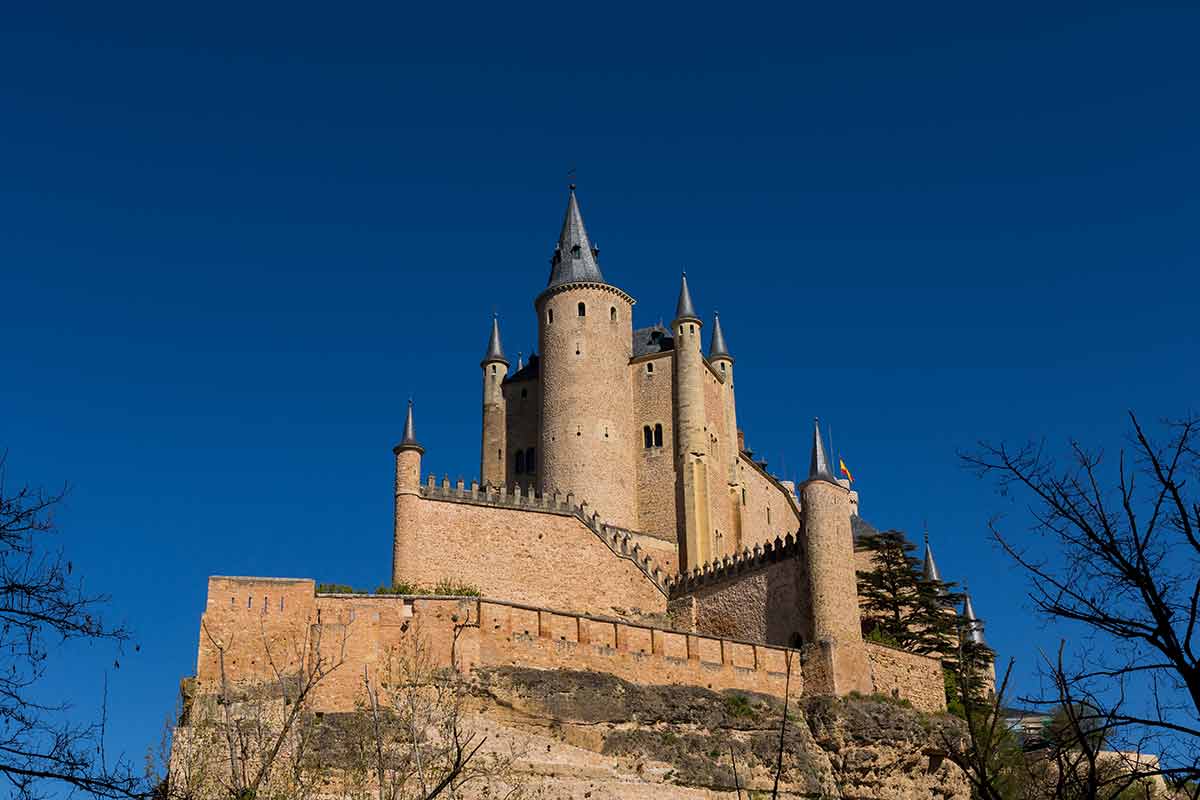
One of Spain’s most unique and renowned castles, the Alcázar of Segovia, stands apart from the rest because of its Austrian appearance.
Some people believe the castle was the inspiration for the world-famous Cinderella Castle at Disneyland.
In 80 BC, the foundations of this site were laid by the Romans.
Then later, around the 8th century, after the Moorish conquest, a wooden fortress was built over the Roman remains.
During the 11th century, under the reign of King Alfonso VIII, the construction of the magnificent castle was completed, giving us the incredible Alcázar we see today.
The Austrian, or Bavarian-style pointed spires, give the castle more of a central European look, and were added during reconstruction by King Phillip II who was married to Anna of Austria.
Inside the Alcázar, you are met with equally extravagant designs throughout the castle.
The golden ceilings in the Hall of the Kings and in the Throne Room are adorned with stunning elaborate designs.
The Armoury Room displays one of the most impressive collections of medieval armour in Spain, while the Alabaster Hall features a wall-sized painting of one of the most significant events in Spanish history, the coronation of Isabella of Castile and León in the 1400s.
Before you depart from this fairytale experience, climb up the 152 steps of the Tower of Juan II to catch a wonderful view of the city and the cathedral from above.
Alcázar of Segovia is at Pl. Reina Victoria Eugenia, s/n, 40003 Segovia.
Recommended tour: Segovia: Guided Walking Tour with Alcázar Entry
2- Marvel At The Aqueduct Of Segovia
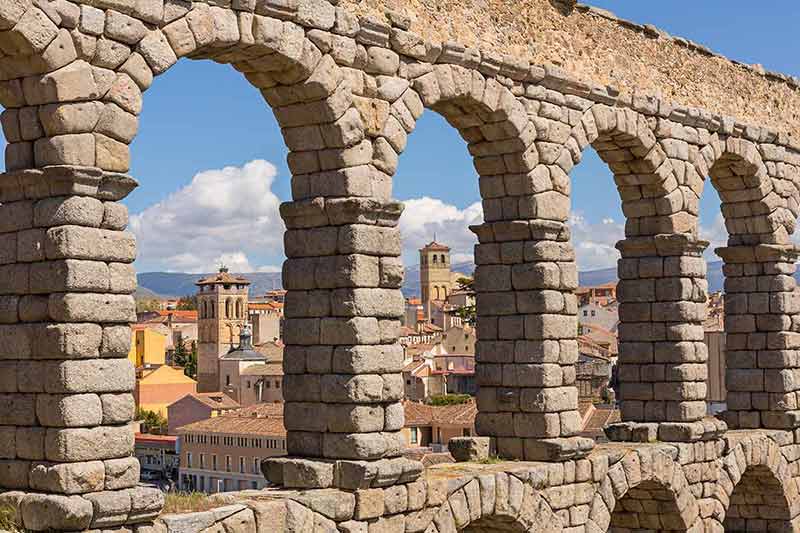
Considered the greatest feat of Roman engineering in Spain, the aqueduct of Segovia towers high above the Plaza del Azoguejo with meticulously crafted arches.
This massive structure, constructed from more than 20,000 granite stones without using mortar, supplied water to the city from the Frio River, 17 km away.
Constructed around 50 BC, this well-preserved aqueduct spans over 813 metres, containing 167 arches on two tiers, and standing over 28 metres above the ground.
Its sheer size and precise engineering are mind-boggling.
It’s almost impossible to imagine the painstaking difficulty of its construction.
Take time to ponder the craftsmanship of the arches and closely examine some of the two-ton, carefully cut granite blocks that form this masterpiece from ancient Rome.
If you climb the stairs near the Segovia tourist office you can reach the Mirador del Aqueducto, which is your first viewpoint about halfway up before the grand view at the Postigo Del Consuelo.
Aqueduct of Segovia is at Pl. Azoguejo, 1, 40001 Segovia.
Recommended tour: Madrid: Segovia and Toledo Tour, Alcazar, and Cathedral
3- Visit The Segovia Cathedral
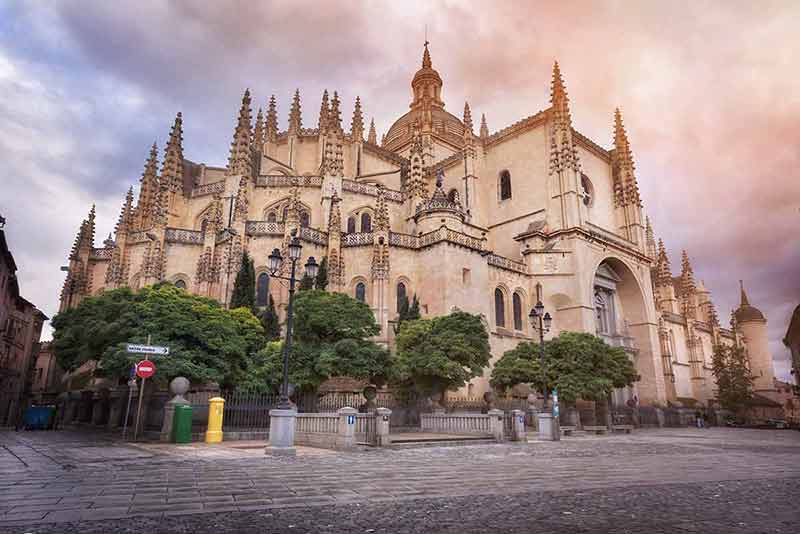
Under King Charles V, the construction of the Segovia Cathedral began in 1525 after a fire destroyed much of the Romanesque cathedral in 1520.
The imposing outer facade, and elegant 18 inner chapels with vaulted ceilings, exemplify high Gothic architecture in Spain and it’s the last one to ever be completed in the country.
Aside from being an impressive place of worship, the interior showcases stunning works of art, the most curious of which is a Baroque painting called ‘The Tree of Life’.
It depicts a festive crowd on top of the tree with people living merrily, and Jesus Christ standing below, about to ring the bell of mortality that hangs from its branches.
While on the opposite side, a skeleton (death) hacks away at its trunk with a scythe.
The cathedral’s foundation rests at the highest point in the city of Segovia.
If you have the courage, climb the 90-metre-high bell tower which provides the most spectacular views of the city, its landmarks, and the wonderful scenery of the surrounding area.
Segovia Cathedral is at C.Marqués del Arco, 1, 40001 Segovia. Skip the line and book your entry tickets here.
4- Wander Around The Royal Palace Of La Granja De San Ildefonso
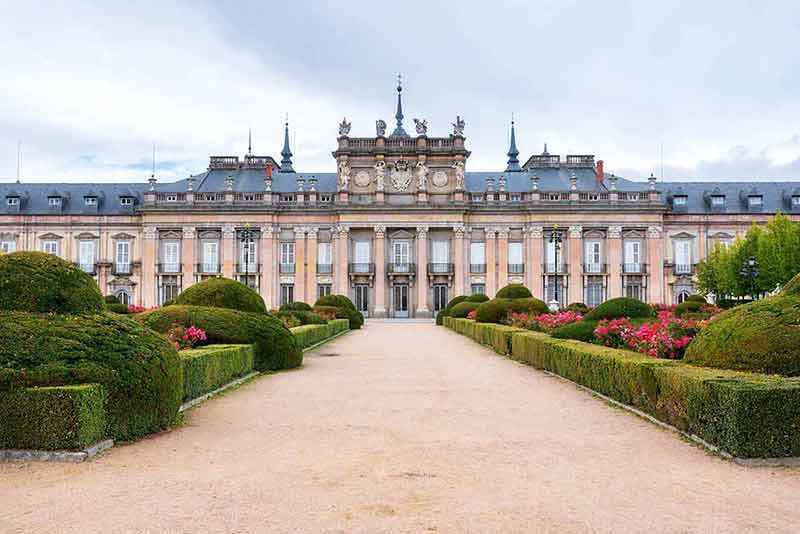
Named after an old farm of the Jerónimos monks, the Royal Palace Of La Granja De San Ildefonso, surrounded by gardens and fountains created in the style of Versailles, allows you to explore the grandeur of the Spanish royalty in the 18th century.
Henry the IV once built a hunting pavilion in this area in 1450, and then later the Catholic Monarchs donated the land to the Jerónimos monks of El Parral.
In the 18th century, King Philip V of the Bourbon dynasty constructed this elegant palace, reminiscent of the architecture found throughout France and other countries in Europe.
As you wander the grounds, look for references to mythology and legends in the statues and fountains.
Inside, take a moment to admire the rooms decorated with marble from Carrara, Japanese lacquer, and dangling crystal chandeliers.
Royal Palace of La Granja de San Ildefonso is at Pl. de España, 15, 40100 Real Sitio de San Ildefonso, Segovia.
Recommended tour: Segovia: Royal Palace of La Granja de San Ildefonso Tour
5- Get The Perfect Photo Of The Alcázar At Mirador De La Pradera De San Marcos
If you’ve come to Segovia to gaze at the beauty of the Alcázar from below and get the perfect photo, then definitely take a moment and walk to the Mirador de da Pradera de San Marcos, an open grassy area that looks up from beneath the castle.
To get here pass through the Puerta de San Andres and look for signs that lead you to the valley of the Clamores.
Once you cross the main road, descend a small hill that will bring you to a large meadow west of the Alcázar, a great place for a picnic and lots of pictures!
Mirador de la Pradera de San Marcos is at C. de San Marcos, 19, 40003 Segovia.
Recommended tour: Segovia: Nighttime Walking Tour
6- Start Your Day At Puerta De San Andrés
On your first day exploring the best sites of Segovia, the best place to start is by entering the old part of the city through the massive defensive gate known as Puerta de San Andrés.
In the past, this gateway served as an entry point to the Jewish Quarter of Segovia.
Be sure to stop by the tourist office and collect the code that opens the door at the top of the nearby staircase, which allows you to walk inside the city’s massive defensive walls.
Puerta de San Andrés is at C. Martínez Campos, s/n, 40003 Segovia.
7- Discover The Jewish Quarter
What used to be one of the wealthiest neighbourhoods in Castile, this section of the city dates back to the 1200s when it was largely inhabited by the Jewish community.
In the early part of the 15th century, the main synagogue was converted into a church after being accused of desecration.
In the latter part of the century, when the Catholic kings took control, they decided to cut this section off from the rest of the city.
The neighbourhood now attracts many visitors eager to learn more about its history and walk the tiny streets from almost a century ago.
The Jewish Quarter is south of the walled section of the city.
Recommended tour: Madrid: Avila and Segovia Day Trip with Tickets to Monuments
8- See The Iglesia De La Vera Cruz
Not far from the Alcázar, you can find the Iglesia de la Vera Cruz, a small church built by the Knights Templar in the 13th century.
Its name means the “Church of the True Cross’ because of its 12-sided polygonal design based on the Church of the Holy Sepulchre in Jerusalem, which is said to be where Jesus was crucified and buried.
Iglesia de la Vera Cruz is at Tr.ª Zamarramala, s/n, 40003 Segovia.
9- Be Amazed By Casa Del Los Picos
An astounding 617 pyramid peaks made from granite cover the main facade of this building built in the 1400s.
The name actually means “House of the Peaks” and it draws many of Segovia’s visitors to ponder its unique design.
Housed inside is the Segovia School of Arts.
Although you cannot go inside the building, it’s still worth taking a moment to appreciate its very unusual exterior design.
Casa del Los Picos is at C. Juan Bravo, 33, 40001 Segovia.
10- Stare Off Into The Distance At The Mirador de la Canaleja
Located just a few hundred feet from the Casa del Los Picos, Mirador de la Canaleja looks across the roofs of the city, with the enormous mountains in the background.
It’s a great place to stop and catch your breath and look across the beauty of Segovia.
Mirador de la Canaleja is at Bajada de la Canaleja, 2, 4, 40001 Segovia.
11- Have Lunch Or Dinner In Plaza Mayor
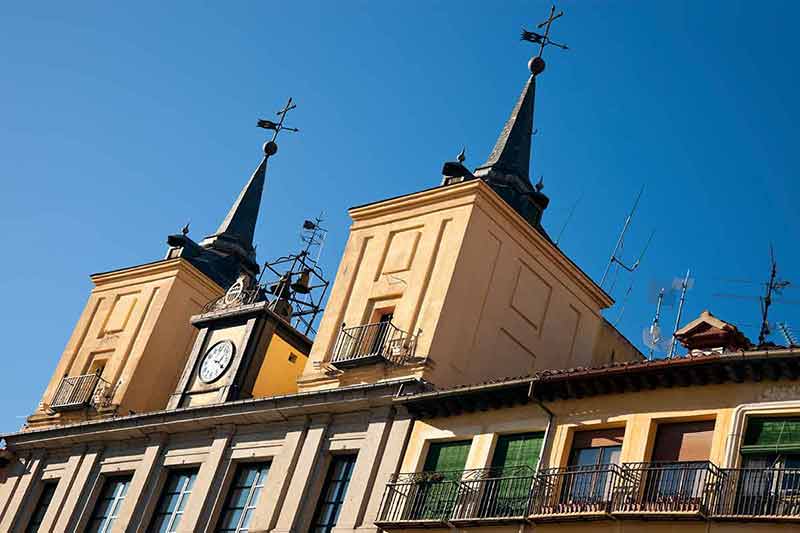
The bustling town square, Plaza Mayor, is the perfect place to rest for a moment and try some tapas or get a drink at one of the many bars and cafes.
From here you can see a fantastic view of the Segovia Cathedral and watch people heading in every direction.
During the evening, the lights and atmosphere of the town square become even more inviting.
Be sure to stop by the Plaza Mayor on your way home for the night, to see the illuminated cathedral or perhaps stay and have a pleasant dinner.
12- Watch The Sunset From Mirador del Alcázar y los dos Valles
If you are looking for the most spectacular views of the Alcázar from above, the Mirador del Alcázar y los dos Valles will grant your wish.
After a short but steep climb up a path from Carrer Cuesta de los Hoyos, you will reach the first viewpoint called Mirador del Último Pino.
From there, continue on just a bit further to reach the Mirador del Alcázar where the castle almost seems to look like a battleship blazing through the valleys.
Try to arrive well before sunset to catch the last of the light reflecting off of the Alcázar in golden hues.
If you don’t mind wandering back down in the dark, stay a bit longer to see when the castle becomes lit up against the dark and starry sky.
It’s a truly magical experience.
Mirador del Alcázar y los dos Valles is at Calle Cuesta de los Hoyos, Segovia.
13- Walk Around The Medieval Walls of Segovia
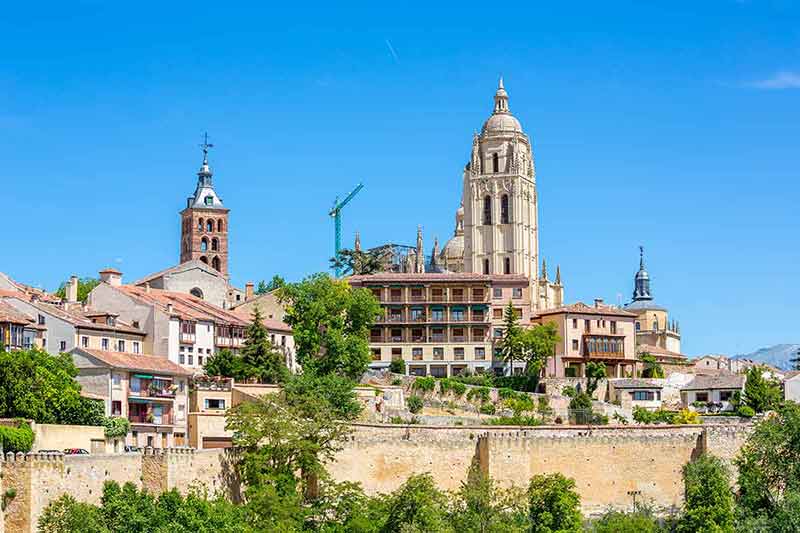
Stretching over 3.5 km around the city, the Walls of Segovia measure a gigantic 3.5 metres thick and 10 metres down to the base.
Built as a defensive border to protect the people inside of the city from Arab invasion, the medieval walls add to the magnificence of Segovia.
Recommended tour: Segovia: Guided Walking Tour with Cathedral & Alcázar Entry
14- Admire The Romaneque Architecture Of Iglesia De San Martín
Located between the cathedral and aqueduct, the Iglesia De San Martín, constructed in the 12th-13th century on top of a 10th-century Mozarabic temple, is now one of the most emblematic Romanesque temples in the region.
Eight centuries of reconstructions and additions changed the outer appearance while inside, many of the original designs were preserved.
The large bell tower represents both Romanesque and Mudéjar styles of architecture.
Its domineering stature over the plaza draws attention from all directions.
Iglesia de San Martín is at C. José Canalejas, 4, 40001 Segovia.
15- Take A Stroll Down Calle Juan Bravo
Segovia’s most famous street, Calle Juan Bravo leads you down a journey through history in the heart of the city.
Lined with clothing and gift shops, it’s a perfect place to window shop or stop and rest at a cafe or restaurant just to watch the people passing by.
16- Learn How Coins Were Made At Museo Real Casa De Moneda De Segovia
It’s not very often that you have the opportunity to see a manufacturing process so unique while travelling.
The Museo Real Casa De Moneda De Segovia or Royal Mint is one of the most important examples of this process that has survived since the 16th century.
Located on the banks of the Eresma River, the factory built in 1583 was designed by the architect Juan de Herrara for King Flippe II who wished to establish a mint in Spain that would pioneer a new coining technique using a roller.
Museo Real Casa de Moneda de Segovia is at C. la Moneda, s/n, 40003 Segovia.
17- Try The Delicious Cochinillo (Suckling Pig)
This local favourite takes the meat from a baby pig slaughtered between three and four weeks old and slow roasts it in a special oven, which creates the most mouthwatering and tender pork you could ever imagine.
Several restaurants around the city offer this exquisite plate, some with their own little twist in flavours, but one thing is for sure.
No visit to Segovia is complete without having a taste of its most famous dish, Cochinillo or Suckling Pig.
18- Examine The Collection Of Artefacts At Museo De Segovia (Casa del Sol)
Not too far from the Puerta de San Andrés, you can find the Segovia Museum and its display of more than 1,500 artefacts including coins, pottery, and paintings.
Some of the more interesting pieces to see are the Roman mosaics, the collections of glass pieces made by the Royal Factory of La Granja de San Ildefonso, and engravings made by Rembrandt.
Museo de Segovia is at C. del Socorro, 11, 40003 Segovia.
19- Make A Quick Stop At Iglesia de San Millan
Often overlooked by many visitors to Segovia, the Iglesia de San Millan, one of the oldest churches in the city, blends two distinct styles of architecture into one.
The Moorish bell tower, first built in the 11th century seamlessly connects with the remainder of the building constructed in the 12th century, showcasing the Romanesque style of design.
After seeing the aqueduct, take a moment to go inside and see the interior of the church and see the large frescos painted on the walls and intricately carved capitals on the tops of each of the columns.
Iglesia de San Millan is located at Av. Acueducto, s/n, 40002 Segovia.
20- Hike Along The River Eresma
For those wishing to spend some time in nature, the hiking trails below the Alcázar and along the river Eresma are perfect for an afternoon outdoors.
You can begin your trek from Museo Real Casa de Moneda and make your way through the lush vegetation until finally ending at the Mirador De La Pradera De San Marcos.
The winding trails lead in many directions bringing you to various sites inside the forest.
Look for signs that say ‘Paseo del Eresma’ if you wish to go directly to the open meadow to relax.
The Paseo is at P.º del Eresma, 40003 Segovia.
Recommended tour: Segovia: Hot Air Balloon Ride with Optional Pickup Service
Love Spain? Read these posts:
- 27 Spanish Shows On Netflix
- 20 Fairytale Castles In Spain
- 30 Landmarks in Spain
- 20 Places To Visit In Spain In Winter
- 20 Best Beaches In Spain
- An Amazing Andalusia Road Trip
- 20 Things To Do In Ibiza
- 20 Things To Do In Tenerife
- 21 Things To Do In Lanzarote
- 21 Spanish Drinks To Try
- 20 Things To Do In Madrid At Night
- 20 Day Trips From Madrid
- Best Time To Visit Spain
- 20 Cities in Spain
- Renting A Car In Barcelona
- 20 Things To Do In Seville
- 20 Things To Do In Granada
- 20 Things To Do In Zaragoza
- 20 Things To Do In Palma
- 20 Tours In Spain
- 20 Things To Do In Alicante
- 20 Spanish Food / Dishes
- 20 Things To Do In Ronda
- 20 Things To Do In Cadiz
- 20 Thing To Do In Benalmadena
- 20 Things To Do In Torremolinos
- 20 Landmarks In Barcelona
- 5 Day Trips From Barcelona
- Barcelona Bike Tour
- 10 Things To Do In Bilbao
- 12 Things To Do In San Sebastian
- 10 Things To Do In Oviedo
- Storybook Village of Santillana del Mar
- 20 Things To Do In Gran Canaria
- 20 Things To Do In Barcelona At Night
- Christmas in Spain
- 20 Things To Do In Malaga
- 20 Things To Do In Marbella
- 20 Things To Do In Valencia
- Where To Stay In Valencia
- Ibiza At Night
- 20 Things To Do In Ibiza
- 20 Things To Do In Toledo
- Where To Stay in Barcelona
- 20 Things To Do In Segovia
- Where To Stay in Tenerife
- Where To Stay in Madrid
- Where To Stay In Mallorca
- Where To Stay In Ibiza
- 15 Things Spain Is Famous For
Plan Your Trip

Rent A Car – Find the best car rental rates at Discover Cars. They compare car hire companies to provide you with the best deal right now.

Find A Hotel – If you’re curious about this article and are looking for somewhere to stay, take a look at these amazing hotels.

